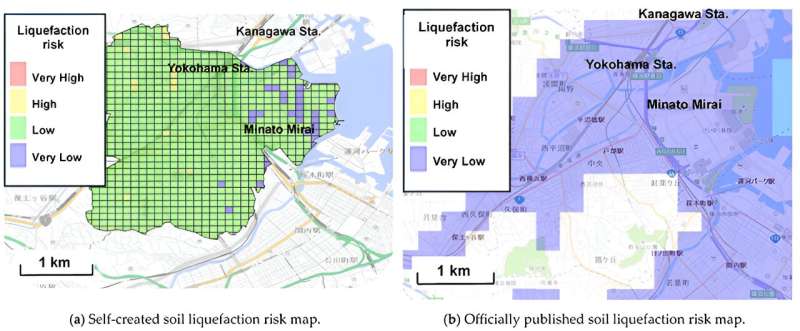This article has been reviewed according to Science X's editorial process and policies. Editors have highlighted the following attributes while ensuring the content's credibility:
fact-checked
trusted source
proofread
Predicting soil liquefaction risk using artificial intelligence

Soil liquefaction that results in infrastructure damage has long been a point of contention for urban planners and engineers. Accurately predicting the soil liquefaction risk of a region could help overcome this challenge.
Accordingly, researchers from the Shibaura Institute of Technology, Japan, have applied artificial intelligence to generate soil liquefaction risk maps, superseding already published risk maps. Although this study focuses on the example of Yokohama, the findings have far-reaching implications for developing smart cities worldwide.
The development of human societies is concurrent with infrastructural changes, evidenced by rapid urbanization in recent years. We are moving towards the era of smart cities powered by advanced technology—such as artificial intelligence (AI), the Internet of Things, and big data analytics—for sustainable urban development. However, climate change has been hampering this growth—earthquakes and other natural hazards negatively impact buildings and other structures in their wake.
Soil liquefaction is an example of a natural hazard where saturated soil substantially loses strength and stiffness in response to stress, typically due to earthquake-related shaking or other rapid loading. This process causes the soil to behave like a liquid, reducing its ability to support infrastructure. Overcoming challenges such as soil liquefaction is, thus, the need of the hour.
Accordingly, researchers from the Shibaura Institute of Technology, Japan, developed a predictive model using AI capable of generating comprehensive soil liquefaction risk maps. The study was led by Professor Shinya Inazumi and involved Arisa Katsuumi and Yuxin Cong. Their findings were published on 17 July 2024 in the journal Smart Cities.
Regarding his motivation to pursue this research, Prof. Inazumi says, "We were motivated to pursue this research after we recognized the urgent need to improve urban resilience to earthquakes, especially in rapidly urbanizing areas prone to seismic activity—there are critical weaknesses in existing geotechnical risk assessments and urban planning strategies.
"Since traditional methods for predicting soil liquefaction are often limited by the scale of data integration and speed of analysis, resulting in gaps in emergency preparedness and risk management, we decided to leverage advanced technologies such as AI and machine learning to develop a more dynamic and accurate predictive model."
Indeed, Prof. Inazumi and his research group integrated advanced machine learning techniques with geotechnical and geographical data to develop this predictive model. They then successfully applied this model to enhance urban planning and infrastructure development in Yokohama, Japan—an area particularly vulnerable to soil liquefaction due to its extensive reclaimed lands and frequent seismic activity.
Notably, the developed model used a combination of machine learning models—such as artificial neural networks and gradient-boosting decision trees—to improve the accuracy in predicting soil liquefaction risk. The researchers achieved high accuracy in predicting soil classifications and N-values (crucial for evaluating soil liquefaction risk). They validated the effectiveness of the model against extensive geotechnical survey data.
Prof. Inazumi says, "The real-world application of our research is the development of hazard maps which can help urban planners and engineers to visualize and identify areas at high risk for soil liquefaction and make informed decisions regarding the development of infrastructures.
"Apart from bolstering emergency response planning, this AI-driven approach can also facilitate community engagement and education by providing clear and accessible information about at-risk areas."
The study highlights transformative developments in geotechnical engineering involving AI integration into soil liquefaction risk prediction. This novel approach bolsters the efforts for urban resilience and corresponding sustainability.
More information: Arisa Katsuumi et al, AI-Driven Prediction and Mapping of Soil Liquefaction Risks for Enhancing Earthquake Resilience in Smart Cities, Smart Cities (2024). DOI: 10.3390/smartcities7040071
Provided by Shibaura Institute of Technology



















